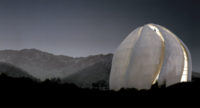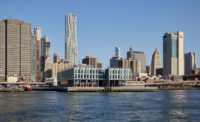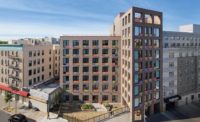From the center of Johannesburg, it takes a minibus taxi about an hour to get to Diepsloot, a poor, densely populated settlement beyond the fringes of the city's wealthy suburbs. Trips in the privately managed minibuses—often the only affordable transportation—usually begin and end inauspiciously on a dusty field or at a dark shed surrounded by hundreds of other vehicles. But now travelers to Diepsloot arrive at a very different kind of place: a refurbished taxi station (or rank) that combines bold graphics and an engagement with the small-scale entrepreneurs who bring vitality to South Africa's urban streets.
In the less than 20 years since its establishment, first as an informal settlement and then as a dumping site for evicted squatters, Diepsloot has grown in an ad hoc way with camplike construction and self-built housing. It now has a population of roughly 200,000 people, including immigrants from other African countries, rural job seekers, and low-paid employees who work in Johannesburg's rich northern suburbs, says Anton Harber in his 2011 book Diepsloot: A Place at the Side of the Road. Despite its newness and its distance from the city center, the settlement has developed an intricate urban fabric, largely through residents' often-ingenious appropriation of the spaces between its simple buildings.
Thorsten Deckler and Anne Graupner of the Johannesburg firm 26'10 South Architects have been preoccupied with these interstitial spaces since the Johannesburg Development Agency (JDA) appointed them in 2008 to survey one of Diepsloot's main roads, ahead of an upgrade that would relocate the numerous small enterprises encroaching on the street. But as the architects documented the fabric of these shops and social spaces, they realized the effectiveness of self-built, microscaled places in humanizing Diepsloot's urban environment. So they developed an alternative plan to improve the housing stock through small catalytic projects—an effort that unfortunately did not move forward.
Deckler and Graupner have since applied their insights to another JDA project, the renovation and expansion of Taxi Rank No. 2, Diepsloot's main minibus station, asserting the role of microenterprises in the organization of the urban realm. Their design makes significant changes to the existing rank, a utilitarian shed that was set back from the street. The architects lengthened the structure and brought more daylight inside by adding pitched roofs with clerestory glazing above some of the original barrel vaults. They also enlarged a small block of offices and encircled it with a curving brick wall that softens its profile. Other improvements include an expanded toilet block, a service bay for the vehicles, and a new area for garbage bins.
From the street, the most visible portion of the project is a new 400-foot-long structure that functions as a colorful gateway to the taxi queues and flexible space for small shops and services. Constructed on a tight budget with prefabricated steelwork and local labor, this long, narrow building mediates between the taxi area and the street several steps below. Stalls set behind steel roller doors are allocated to traders who sell food, household items, cellular airtime, and clothing, and whose activities create a safer environment for people arriving at the rank in the early morning and at night. An overhanging roof lets shops spill out onto the pavement during the day, while cross-ventilation keeps the covered spaces cool and chimneys remove smoke from stalls where food is cooked. The architects envisage using the stoa-like building's roof for harvesting rainwater and its chimneys as supports for billboards that might provide an extra source of revenue.
Rodgers Makhubele, the local councillor, watched the project throughout its three-year gestation (from December 2008 to December 2011) and is excited about its potential as a model for local development. He understands that the new stalls facing the street will bring immediate value and vitality to the precinct, while other opportunities for the project as a whole develop over time. Makhubele would like to negotiate with the taxi companies and the rank's management to establish a community radio station there and add public art, banking facilities, and temporary stalls and eateries on the north side of the retail building. What he pictures is urbanity itself, happening through an architecture that has secured a space within which it can take place.
PeopleClient: Johannesburg Devlopment Agency
Architect and Site Design: 26’10 South Architects & Urban Designers Personnel in architect's firm who should receive special credit: Thorsten Deckler (principal, registered architect)
Engineer(s): Civil & Structural: Hlanganani Consulting Engineers & Project Manageers Electrical: Selanya Consulting Engineers
Consultant(s): Other:
General contractor: Dryden Construction
Photographer(s): +31 (0)6 5463 0468 |
ProductsStructural system Concrete, bricks, steel frame– Drydon Construction
Exterior cladding Masonry: Corobrik – Mahonie Satin Precast concrete: (Interlocking conc. Pavers) Infraset Moisture barrier: (waterproofing) Derbigum
Roofing Metal: (Roof sheeting) Chromadek Other: (IBR Polycarbonate sheeting) Modek
Windows Metal frame: Durowin
Other: Metal grating: Andrew Mentis
Interior finishes Paints and stains: Prominent paints Ceilings: Rhino board |








